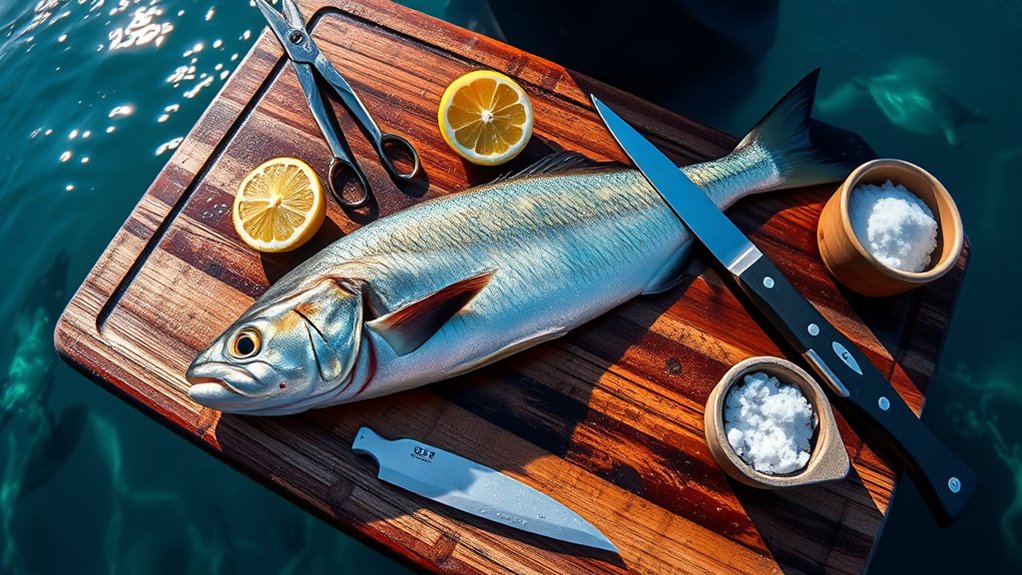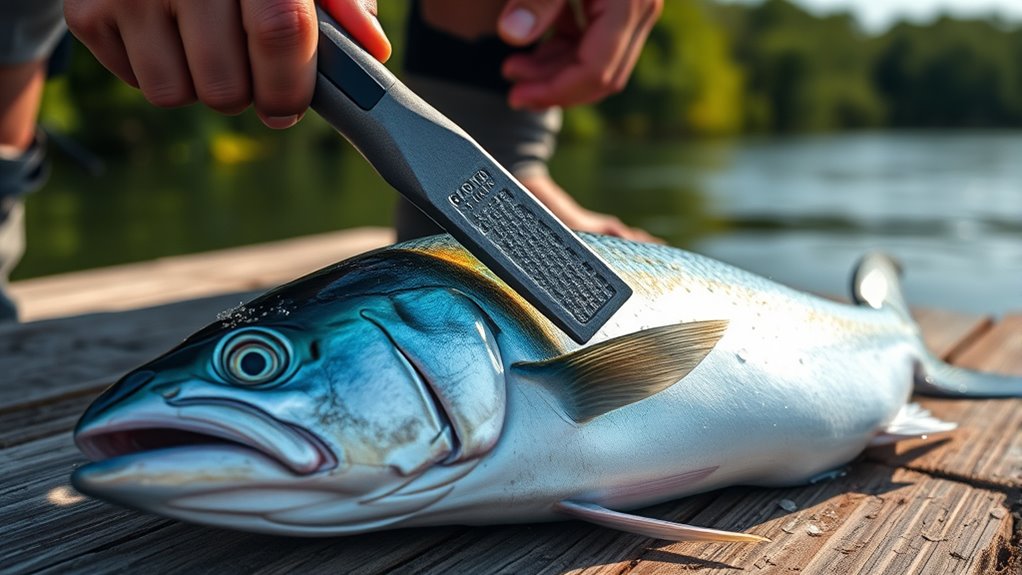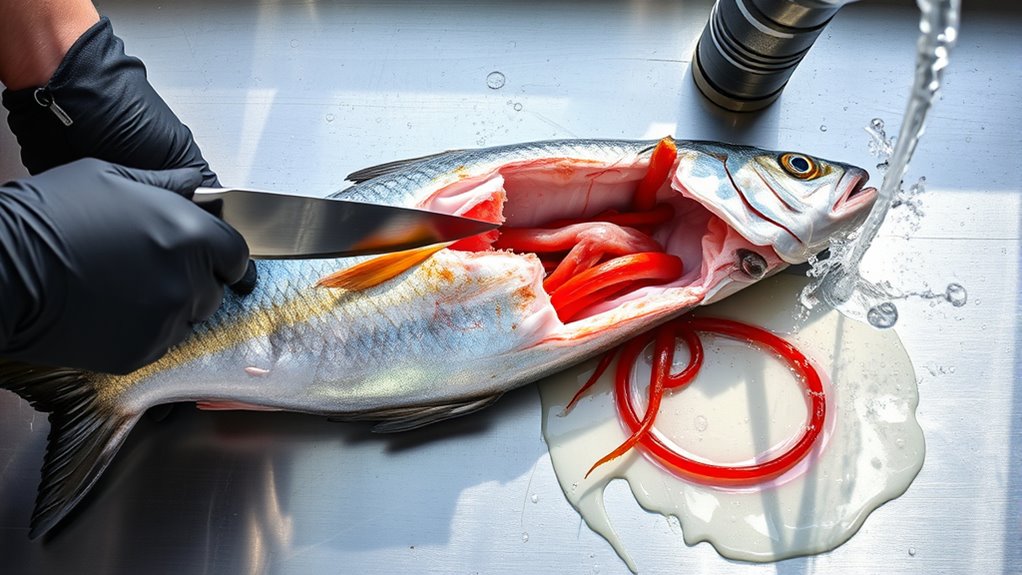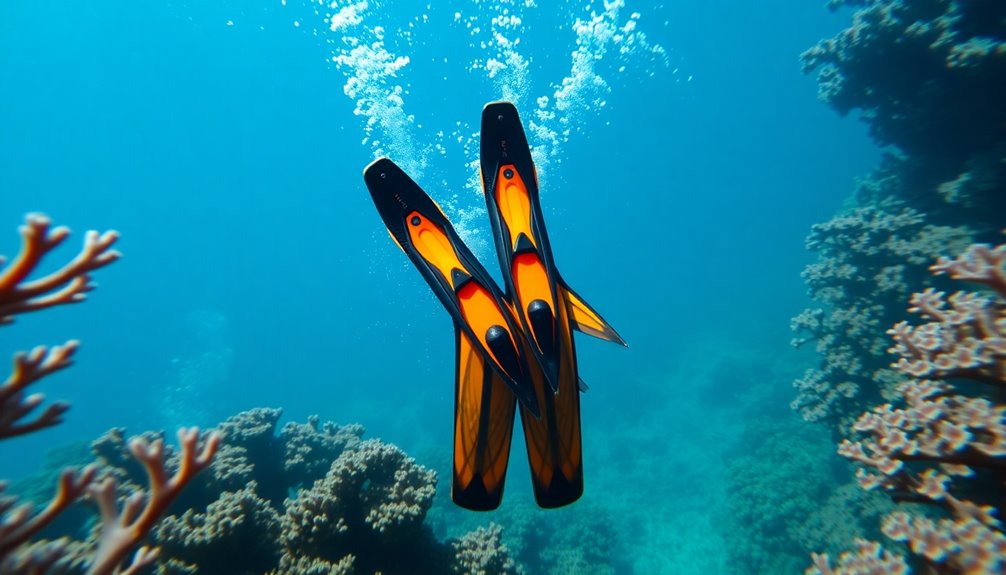After your spearfishing trip, start by rinsing your fish and gear with fresh water. Work outdoors and remove scales using a scraper, then cut behind the gills to remove them and gut the fish through its anal opening. Rinse thoroughly outside, then fillet using a sharp knife, saving the best parts like cheeks and flavorful bits. Season and cook on a hot grill for 10-15 minutes. Keep going to discover more tips for perfect prep and delicious results.
Key Takeaways
- Rinse the fish with fresh water after spearfishing to remove salt, debris, and prevent corrosion.
- Descale outdoors using a lobster gauge or similar tool, scraping from tail to head.
- Gut the fish by making a cut in the anal opening and removing internal organs carefully.
- Fillet the fish along the backbone with a sharp knife, saving prized parts like cheeks and throat meat.
- Season with herbs, garlic, lemon, and olive oil, then grill at medium-high heat for 10-15 minutes until cooked through.
Preparing Your Equipment and Fish for Cleaning

Before you start cleaning your spearfished fish, make sure your equipment and fish are ready. After scuba diving, rinse your spear gun and diving gear with fresh water to remove salt and debris, which prevents corrosion and keeps them functioning properly. Prepare a clean outdoor workspace with a cutting board or surface designated for fish cleaning, so scales and guts stay contained. Use a sharp, dedicated fillet knife to make precise cuts, reducing damage to the fish and easing the cleaning process. Start by removing the gills to reduce blood and improve flavor, then cut just behind the head to access the internal cavity. Keep a container or trash bag nearby for quick disposal of guts, scales, and waste, maintaining a tidy work area. Utilizing a self-watering plant pot can help keep your workspace organized and prevent spills while cleaning. Additionally, ensuring proper handling and sanitation can help prevent cross-contamination, preserving the quality of your catch. Proper sanitation practices are essential for maintaining color accuracy and overall freshness of your fish, as proper handling is crucial for avoiding spoilage and ensuring safety.
Removing Scales and Gills Outside

To efficiently remove the scales and gills from your spearfished fish, start by working outdoors to contain any mess. Use a lobster gauge or similar tool to scrape off the scales, working from tail to head for speed. Here are three key steps:
Work outdoors, scrape scales from tail to head, then remove gills for easier cleaning and better flavor.
- Descale the fish outside, applying firm but gentle pressure to avoid damaging the skin.
- Use a knife or gill cutter inserted behind the head to cut or pull out the gills, ensuring a clean cavity.
- Carefully rip out or cut free the gills to improve flavor and make future cleaning easier. Performing these steps outdoors helps keep your cleaning area tidy, and removing the scales and gills sets the stage for a smooth, effective cleaning process. Additionally, understanding proper cleaning techniques can enhance your overall grocery savings strategies by reducing wastage and ensuring freshness.
Gutting and Rinsing the Fish

Gutting and rinsing your spearfished fish promptly guarantees it stays fresh and safe to eat. To gut the fish, insert a knife tip into the anal opening and rip out the guts, minimizing mess and preserving the meat’s quality. Carefully remove the gills by cutting or pulling them out to prevent contamination and prepare the fish for cleaning. Once gutted, rinse the fish thoroughly with clean water outside to remove blood, scales, and residual guts. This step ensures the fish is hygienic and ready for the next stage. Using a lobster gauge or similar tool can help descale larger fish efficiently. Proper home cleaning practices can also help improve presentation for any seafood-themed events. After gutting and rinsing, you can proceed to fillet or cook your fish immediately, maintaining its freshness and flavor.
Filleting and Saving the Best Parts

When filleting your spearfished fish, using a sharp fillet knife helps you cut smoothly along the backbone and ribcage, minimizing meat loss. Carefully remove the fillet from the fish, keeping it intact. As you work, focus on these key steps: Save the cheek meat—these small, flavorful bits are easy to extract and taste fantastic. Peel back the skin if you prefer skinless fillets or want to preserve the skin for presentation. Collect bite-sized parts like throat meat and other small, tasty sections for extra flavor. Be sure to remove the gills and guts thoroughly to prevent bitterness. Keep the fillets and prized parts on ice until you’re ready to cook. Proper handling and cleanliness are essential for maintaining the freshness and quality of your catch, especially when considering the vetted safety of your fish. Regularly cleaning your tools and workspace helps prevent contamination and keeps your catch in optimal condition. Additionally, understanding appliance safety measures ensures that your cleaning process remains efficient and hazard-free. Incorporating techniques like mindfulness during handling can also help maintain focus and precision, ensuring a cleaner and safer process. Being aware of the mechanics involved in cleaning your fish can help you avoid damaging the fillets and preserve the best parts of your catch.
Seasoning and Cooking Methods for Fresh Fish

Once your fish is cleaned and filleted, seasoning it properly can elevate its natural flavors and make your meal unforgettable. Use ingredients like butter, olive oil, garlic, lemon, and onions to enhance the fillet’s taste. For extra flavor, consider creative seasonings such as orange ginger pepper jelly jam. To guarantee the seasoning penetrates, score the fish skin or flesh before cooking. Grilling is a great method; preheat your grill to medium-high and cook the fillet at around 375°F for 10-15 minutes, flipping as needed. Keep an eye on the fish to avoid overcooking. Proper payment processing and cooking techniques are essential for a delicious meal, and using fresh fish ensures the best flavor and texture. Additionally, understanding AI vulnerabilities can help in developing safer food preparation technologies. Incorporating nutritional benefits into your seasoning choices can also boost the healthiness of your dish. Adjust seasonings to suit your preferences, and enjoy a flavorful, perfectly cooked fish. Adding a marinade with keto-friendly ingredients can also help enhance flavor without compromising your dietary goals.
Frequently Asked Questions
How Do You Properly Clean Fish Before Cooking?
To properly clean fish before cooking, you start by removing the scales with a fish scaler or the back of a knife, working from tail to head outside. Next, make a small incision near the gill cover, take out the gills, and rip out the guts through the anal opening. Rinse the fish thoroughly, then score the skin or flesh to enhance flavor absorption. Keep it cold until you’re ready to cook.
How to Gut a Fish Spearfishing?
Imagine revealing a hidden treasure—you’re about to reveal the fish’s insides. First, make a small cut behind the gills, then slice along the belly from the vent to the head. Ripping out the guts through the opening speeds things up. Use gloves or a paper towel to keep clean. Carefully remove the organs, avoiding punctures, then rinse the cavity thoroughly. Now, your fish is ready for the next step!
How to Cook Unicorn Fish?
To cook unicorn fish, start by seasoning the fillets with herbs, garlic, and lemon. You can bake, grill, or pan-fry them, guaranteeing the flesh turns opaque and flakes easily. For added flavor, consider scoring the flesh before cooking. Keep the heat moderate to prevent overcooking, and serve your fish hot with your favorite sides. This method guarantees a delicious, tender result every time.
How to Prepare a Fish After Catching It?
When you’ve caught a fish, you want to hit the ground running. First, use a lobster gauge or similar tool to descale it outside, keeping your space clean. Next, remove the gills and guts with a sharp knife, then bleed the fish near the gills or tail. Score the skin for flavor, fillet it, and season with garlic, lemon, or your favorite spices. Now, you’re ready to cook!
Conclusion
Think of your freshly spearfished fish as a blank canvas, ready to be brought to life through your care. Cleaning and cooking it transforms raw potential into a delicious masterpiece, symbolizing your connection to the sea’s bounty. With each step, you’re not just preparing a meal, but forging a bond with nature’s gift. As the flavors unfold, remember—your effort turns simple ingredients into a vibrant story of craftsmanship and respect for the ocean.










